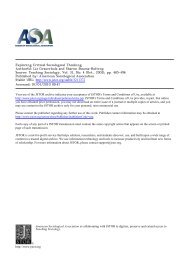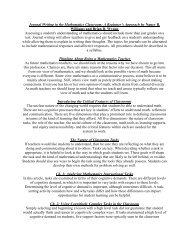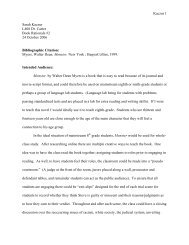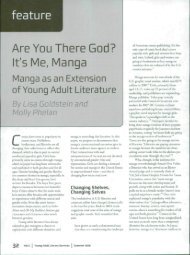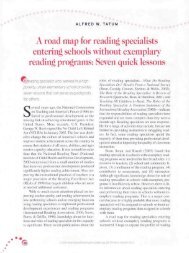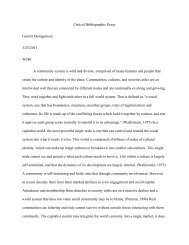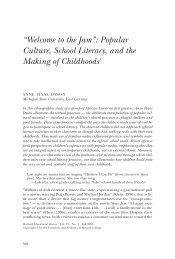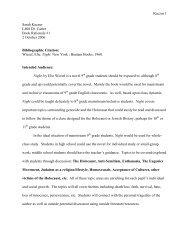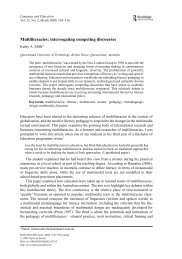McDonald 2004 Critical Reading 10-11 year olds.pdf - Oncourse
McDonald 2004 Critical Reading 10-11 year olds.pdf - Oncourse
McDonald 2004 Critical Reading 10-11 year olds.pdf - Oncourse
You also want an ePaper? Increase the reach of your titles
YUMPU automatically turns print PDFs into web optimized ePapers that Google loves.
18 Moving from reader response to critical reading<br />
students investigate how this positioning occurs, and<br />
they may offer resistant readings to ‘mainstream’ ways<br />
of thinking articulated in the story. In this article, the<br />
term ‘mainstream’ signifies an assumption of ‘normal’,<br />
‘typical’ and ‘universal’ for dominant social and<br />
cultural practices (Baynham, 1995, p. 43). <strong>Critical</strong>/<br />
analytical practices have been seen, therefore, to<br />
propose an alternative to dominant reader-response<br />
interpretations of texts. The research presented here<br />
suggests, however, that a reader response stance can<br />
contribute to the formation of a critical reading<br />
position. The article concludes with the notion of a<br />
response-critical continuum which may be a useful<br />
concept for introducing young readers to alternative<br />
ways of thinking about literary texts.<br />
The term ‘critical reading’ here encapsulates alternative<br />
ways of reading which go beyond typical<br />
approaches to reading as word recognition, information<br />
processing, and personal response. Today, critical<br />
ways of reading are intended to construct readers who,<br />
for example, can identify texts as crafted objects, who<br />
are alert to the values and interests espoused by the<br />
text, who recognise their position as compliant or<br />
resistant readers. When readers perceive texts as<br />
motivated, rather than innocent, they position themselves<br />
within an alternative discourse of reading,<br />
participating in a critical literacy. Current Australian<br />
English syllabi require teachers to employ pedagogies<br />
that enable students to take up a position within such<br />
an alternative reading discourse.<br />
Educational issues in literature for primaryage<br />
students<br />
When children’s literature is presented in a classroom<br />
it gains authenticity and authority from its educational<br />
setting. Stories have the ability to ‘naturalise’ their<br />
ideological positions and they ‘subject’ readers to<br />
become their ‘ideal’ readers, that is, to produce<br />
readings that align with the views of the text. As<br />
Candlin states, ‘‘children’s fictional texts are engaged<br />
in a struggle for young people’s minds’’ (Candlin,<br />
1992, p. ix; see also Stephens, 1992).<br />
Furthermore, current reading approaches do not<br />
position teachers to challenge the ways of thinking<br />
and being (the discourses) that stories portray in<br />
classroom texts. The discourses stories present are<br />
perceived as unproblematically ‘neutral’ by these<br />
reading approaches, and by teachers. As discursive<br />
practices, however, all stories constitute, and are<br />
constituted by, ways of thinking which typically<br />
present mainstream views on gender, ethnicity and<br />
social groups. Recently, literary texts which challenge<br />
these mainstream views have been published, and rereadings<br />
of older texts problematise previous interpretations<br />
(for example, The True Story of the Three Little<br />
Pigs, Scieszka, J. (1989), Snow White in New York, French,<br />
F. (1986); see also Bradford, 1996).<br />
The role of the teacher in reading practices<br />
In any classroom, the teacher is the interpretative<br />
authority on the text for the students. The narrative is<br />
filtered through the teacher’s talk about the text, that is,<br />
the teacher mediates the text to the students. As Luke<br />
and Luke (1989, p. 252) note, ‘‘[t]acitly and intentionally,<br />
teachers will emphasize and de-emphasize, select<br />
and exclude’’. The text becomes remade through this<br />
‘‘running metatextual commentary’’ (Luke, de Castell<br />
and Luke, 1983, p. <strong>11</strong>8). Baker’s research on talk in<br />
reading lessons (1991a, 1991b, 1992; and Baker and<br />
Freebody, 1989a, 1989b) highlights how, in the metatextual<br />
commentary, students are ‘‘asked to look<br />
through the text into the story, and through talk into<br />
the world. The text and the talk remain transparent and<br />
unread’’ (Baker, 1991b, p. 176). Together, Baker argues,<br />
the text, and the teacher’s talk about the text,<br />
‘naturally’ construct a subject position within dominant<br />
ways of thinking for the student.<br />
The study<br />
The research discussed in this article was a case study<br />
of how one teacher sought to introduce her students to<br />
critical ways of reading that were distinct from the<br />
interpretative responsive readings employed by the<br />
class and herself in other lessons in the study. The<br />
reading programme took place with students aged ten<br />
to eleven <strong>year</strong>s, in a Year 5 classroom in Sydney,<br />
Australia. The text was a children’s novel which the<br />
teacher read aloud to the class on a daily basis over a<br />
period of a school term (ten weeks). Information about<br />
the study-class cohort is summarised in Table 1.<br />
As can be seen from Table 1, the class contained a<br />
balance of ESB and NESB students, and gender, and<br />
had a wide range of reading abilities. It was important<br />
for the effectiveness of the study that the students not<br />
be categorised as high ability. The teacher and I wanted<br />
to ensure that any critical ways of reading achieved in<br />
the classroom dialogue could be attributed more to the<br />
kinds of talk about literature promoted in the classroom<br />
interaction, rather than to general high reading<br />
ability or a well-established English-speaking background.<br />
The text selected for the study was I am Susannah<br />
(1987), an Australian novel by a multi-award winning<br />
Australian author, Libby Gleeson. The major characterisation<br />
in the novel presents three generations of<br />
women, the protagonist, 12-<strong>year</strong>-old Susie, her mother<br />
Martha, and an elderly neighbour, Jess, known as the<br />
Blue Lady. Each of these characters is ‘matched’ by<br />
another female character who represents more traditional<br />
ways of being for women.<br />
The students responded to the novel through discussion<br />
of various features, events and characters at a<br />
r UKLA 2003



